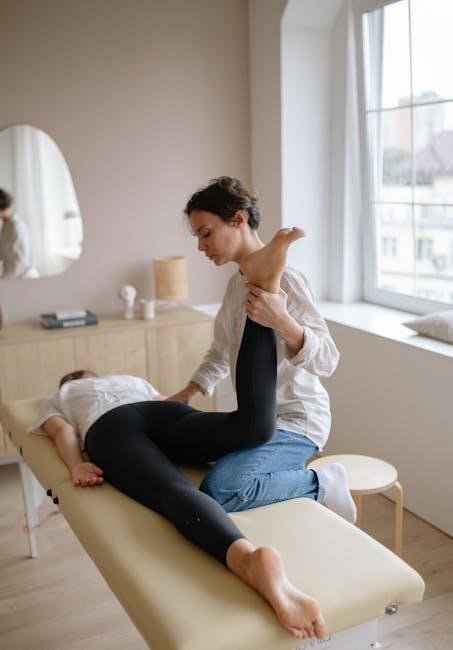Sacroiliac (SI) joint pain is a common issue affecting pelvic stability and mobility. It often mimics low back pain, making diagnosis challenging. Gentle exercises, stretches, and physical therapy are key to managing symptoms and restoring function. A downloadable PDF guide provides comprehensive exercise routines to alleviate discomfort and improve joint stability effectively.
1.1 Understanding SI Joint Pain and Its Prevalence
Sacroiliac joint pain is a common condition affecting pelvic stability and mobility, often mistaken for lower back pain. It frequently impacts women, especially post-pregnancy, and can severely disrupt daily activities and mobility. Understanding its prevalence and symptoms is crucial for effective management and treatment, reducing discomfort and improving quality of life.
SI Joint Anatomy and Function
The sacroiliac joint connects the sacrum to the ilium bones, forming a critical pelvic structure. It acts as a weight-bearing joint, enabling limited movement while providing stability and support.
2.1 Location and Structure of the Sacroiliac Joint
The sacroiliac joint is located between the sacrum and ilium bones on either side of the pelvis. It is a synovial joint with ligaments providing stability. The joint’s structure allows limited movement while distributing forces effectively. Proper alignment and function are crucial for maintaining pelvic stability and preventing pain, making it a key focus in exercise-based treatment plans for SI joint pain.
2.2 The Role of the SI Joint in Pelvic Stability
The SI joint plays a vital role in pelvic stability by acting as a shock absorber and distributing forces between the spine and legs. It enables controlled movement while maintaining structural integrity. A stable SI joint ensures proper weight distribution and supports daily activities, making it essential to target in exercises aimed at alleviating pain and enhancing functionality.

Causes and Symptoms of SI Joint Pain
SI joint pain often arises from inflammation, arthritis, or injury, leading to symptoms like lower back pain, hip discomfort, and stiffness, impacting mobility and daily activities.
3.1 Common Causes of Sacroiliac Joint Dysfunction
Sacroiliac joint dysfunction often results from inflammation, arthritis, or repetitive stress. Trauma, poor posture, or uneven leg lengths can also disrupt joint alignment. Pregnancy-related hormonal changes may weaken ligaments, leading to instability. Aging can cause wear and tear, while sudden injuries or overuse may trigger pain and stiffness, affecting mobility and daily activities. Accurate diagnosis is key to effective treatment.
3.2 Identifying Symptoms of SI Joint Pain
Symptoms of SI joint pain often mimic lower back issues, including discomfort in the buttocks or hips. Pain may radiate to the thighs or groin and worsen with prolonged sitting, standing, or activities like climbing stairs. Stiffness, limited mobility, and tenderness near the joint are common. Accurate diagnosis is crucial, as symptoms can overlap with other conditions, requiring professional evaluation for effective treatment.

The Importance of Exercises for SI Joint Pain Management
Exercises are crucial for reducing SI joint pain and stiffness, improving mobility, and restoring pelvic stability. They strengthen surrounding muscles and enhance joint function, aiding long-term relief.
4.1 How Exercise Reduces Pain and Stiffness
Exercise alleviates SI joint pain by improving joint mobility, strengthening surrounding muscles, and enhancing blood circulation. Gentle stretches reduce muscle tension, while core and glute exercises stabilize the pelvis, minimizing strain on the SI joint. Regular movement prevents stiffness and promotes long-term relief, making it a cornerstone of effective SI joint pain management strategies.
4;2 The Role of Physical Therapy in SI Joint Treatment
Physical therapy plays a crucial role in treating SI joint pain by addressing muscle imbalances and improving joint function. Therapists design personalized exercise plans, including stretches and strengthening exercises, to enhance pelvic stability and reduce discomfort; Manual therapy techniques, such as joint mobilizations, further aid in restoring mobility and alleviating stiffness, promoting a faster recovery and preventing future episodes of pain.

Gentle Stretches for SI Joint Pain Relief
Gentle stretches are essential for relieving SI joint pain by targeting tight muscles and improving joint mobility. They are often recommended in exercise routines to reduce stiffness and discomfort, promoting healing and restoring normal movement patterns.
5.1 Knee-to-Chest Stretch for SI Joint Mobility
The knee-to-chest stretch is a gentle and effective exercise for improving SI joint mobility. Lie on your back, bring one knee toward your chest, and hold for 20-30 seconds. This stretch helps relieve tension in the lower back and hips, reducing SI joint discomfort. It is a key component of many exercise routines for sacroiliac joint pain management, as it promotes flexibility and relaxation in the pelvic region.
5.2 Pelvic Clock Exercise for Sacroiliac Joint Health
The Pelvic Clock Exercise is a simple yet effective stretch for sacroiliac joint health. Lie on your back with knees bent and feet flat. Tilt your pelvis backward and then forward in a gentle, repetitive motion, as if moving a clock’s hands. Hold each position for 5-10 breaths. This exercise improves pelvic mobility and reduces stiffness, aiding in long-term SI joint pain relief and function restoration.
Core Strengthening Exercises
Strengthening core muscles is essential for pelvic and spinal stability, reducing SI joint pain. Exercises like planks and bird dogs target these muscles, improving overall joint function and relief.
6.1 Plank Exercises for Core Stability
Plank exercises are highly effective for core stability, essential for SI joint health. By engaging the transverse abdominis and multifidus muscles, planks improve pelvic alignment and reduce strain on the SI joint. Regular planks can enhance posture, reduce pain, and promote long-term joint stability, making them a cornerstone in SI joint pain management routines.
6.2 Bird Dog Exercise for Spinal and Pelvic Stability
The Bird Dog exercise enhances spinal and pelvic stability by strengthening core muscles. Performed in a quadruped position, it involves extending the opposite arm and leg while maintaining a neutral spine. This exercise improves balance, reduces SI joint strain, and promotes proper pelvic alignment. Holding each position for 5-10 seconds and repeating 10-15 times per side can significantly enhance stability and reduce pain.
Glute Strengthening Exercises
Glute strengthening exercises are crucial for SI joint health, improving hip stability through targeted movements like bridges and side-lying leg lifts, enhancing overall pelvic alignment and pain relief.
7.1 Glute Bridges for Hip Stability
Glute bridges are an effective exercise for strengthening the glutes and improving hip stability, which is essential for SI joint health. By lifting the hips while engaging the core, this movement enhances pelvic alignment and reduces strain on the SI joint. Regular practice can alleviate pain and improve mobility, making it a key component of SI joint exercise routines.
7.2 Side-Lying Leg Lifts for Glute Medius Strength
Side-lying leg lifts target the gluteus medius, crucial for hip and pelvic stability. Lifting the top leg while maintaining proper alignment strengthens the muscles supporting the SI joint. This exercise helps reduce pain and improves functional movement, making it an essential part of an SI joint pain management and prevention program.
Aerobic Exercises for SI Joint Health
Aerobic exercises like swimming and cycling promote blood flow, reducing stiffness and pain. These low-impact activities strengthen surrounding muscles, supporting SI joint stability without excessive stress;
8.1 Swimming as a Low-Impact Exercise Option
Swimming is an excellent low-impact aerobic exercise for SI joint health. It strengthens muscles without stressing the joint, improving mobility and reducing pain. Gentle strokes like breaststroke promote relaxation and stability, while avoiding high-impact movements protects the SI joint. Regular swimming enhances blood circulation, aiding in healing and maintaining pelvic stability over time.
8.2 Cycling for Improved Blood Circulation
Cycling is a low-impact aerobic exercise that enhances blood circulation, benefiting SI joint health. It strengthens muscles without stressing the joint, reducing stiffness and pain. Stationary bikes or gentle outdoor rides are ideal, as they minimize strain. Regular cycling promotes healing, improves mobility, and supports pelvic stability. Start with short sessions and gradually increase duration for optimal benefits and comfort.

Daily Routine for SI Joint Pain Management
A consistent daily routine is essential for managing SI joint pain. Incorporate gentle stretches, core strengthening, and low-impact exercises 2-3 times weekly. Monitor progress and adjust as needed to avoid discomfort. Focus on maintaining proper posture, avoiding repetitive stress, and incorporating aerobic activities like swimming or cycling to enhance circulation and support joint health effectively.
9.1 Recommended Frequency and Duration of Exercises
Exercises for SI joint pain should be performed 2-3 times weekly, with each session lasting 20-30 minutes. Start with gentle stretches like the knee-to-chest stretch and pelvic clock exercise, followed by core strengthening and glute exercises. Monitor your progress and pain levels, adjusting the routine as needed. Avoid overexertion and gradually increase intensity to prevent muscle soreness. Consistency is key for long-term relief and stability.
9.2 Monitoring Progress and Adjusting Your Routine
Track your pain levels and mobility improvements weekly. Use a journal to document exercise tolerance and any discomfort. Adjust routines based on progress, increasing intensity gradually. If pain persists, consult a physical therapist to refine your approach. Consistency is crucial, but avoid overexertion. Tailor exercises to your needs, ensuring a balance between strengthening and flexibility for optimal SI joint health and long-term relief.
When to Stop or Modify Exercises
Stop exercises if pain increases or persists beyond mild discomfort. Modify routines to avoid aggravating the SI joint, focusing on low-impact alternatives to promote healing without exacerbating symptoms.
10.1 Recognizing Signs of Increased Pain or Discomfort
Sharp or radiating pain, increased stiffness, or limited mobility indicate potential overexertion. If exercises exacerbate discomfort, stop immediately and consult a physical therapist to assess and adjust your routine. Mild soreness is normal, but sharp pain signals a need to pause. Ignoring these signs may worsen inflammation or injury, delaying recovery and joint stability goals.
10.2 Modifying Exercises to Suit Individual Needs
Tailor exercises based on pain levels and mobility. Reduce intensity or avoid movements that worsen discomfort. Use supportive devices like belts or braces if needed. Substitute high-impact exercises with low-impact alternatives, such as swimming or cycling. Consult a physical therapist to adapt routines for optimal comfort and effectiveness, ensuring progress without aggravating the SI joint or surrounding tissues.
Advanced Exercises for SI Joint Stability
Advanced exercises strengthen pelvic and spinal stability, improving mobility and reducing pain. They target core engagement and functional strength, enhancing overall joint stability and movement efficiency.
11.1 Single-Leg Stance for Balance and Stability
The single-leg stance improves balance and stability by strengthening the muscles around the SI joint. Stand on one leg, keeping the other foot lifted slightly. Hold for 30 seconds, switch legs. This exercise enhances proprioception, reducing pain and instability. Perform 2-3 sets daily for optimal results. Include in your routine for better pelvic and spinal alignment.
11.2 Step-Ups for Functional Strength
Step-ups target the glutes and improve pelvic stability, essential for SI joint health. Stand in front of a sturdy step or platform. Step up with one leg, keeping the knee slightly bent. Push through your working leg to return to the starting position. Perform 10-15 reps per leg, focusing on controlled movements. Start with a low step and gradually increase height as strength improves. Incorporate into your routine for enhanced lower body strength and SI joint support.
Preventive Measures for Long-Term Relief
Maintaining proper posture, avoiding repetitive stress, and incorporating regular stretching can prevent SI joint pain. Ergonomic adjustments and taking frequent breaks help reduce strain, promoting long-term relief.
12.1 Maintaining Proper Posture and Ergonomics
Maintaining proper posture and ergonomics is crucial for reducing SI joint strain. Adjust workstations to promote neutral spine alignment, and take regular breaks to stretch and move. Good posture distributes weight evenly, minimizing pressure on the SI joint. Ergonomic adjustments at home and work can significantly reduce long-term discomfort and prevent pain recurrence.
12.2 Avoiding Repetitive Stress on the SI Joint
Avoiding repetitive stress on the SI joint is essential for long-term relief. Limit activities involving heavy lifting, prolonged sitting, or repetitive twisting. Incorporate regular breaks to stretch and move, especially during tasks that involve sitting or standing for extended periods. Ergonomic adjustments and activity modification can significantly reduce strain on the SI joint, preventing pain recurrence and promoting overall pelvic stability.
Thank you for exploring this guide on SI joint pain exercises. Download the comprehensive PDF guide for detailed routines and tips to manage sacroiliac joint discomfort effectively.
13.1 Summary of Key Exercises for SI Joint Pain
Key exercises for SI joint pain include knee-to-chest stretches, pelvic clock, planks, bird dog, glute bridges, and side-lying leg lifts. These exercises improve mobility, reduce stiffness, and enhance pelvic stability. Aerobic activities like swimming and cycling also support joint health. Consistency and proper form are crucial for effective pain relief and long-term management. These exercises are part of a holistic approach to addressing SI joint discomfort.
13.2 Downloadable PDF Guide for SI Joint Exercises
A downloadable PDF guide provides a comprehensive resource for managing SI joint pain through targeted exercises. It includes detailed instructions for stretches, strengthening routines, and aerobic activities. The guide emphasizes proper form and consistency, offering a structured approach to alleviate discomfort and improve joint stability. This evidence-based resource is designed to empower individuals with effective tools for long-term pain relief and enhanced mobility.
